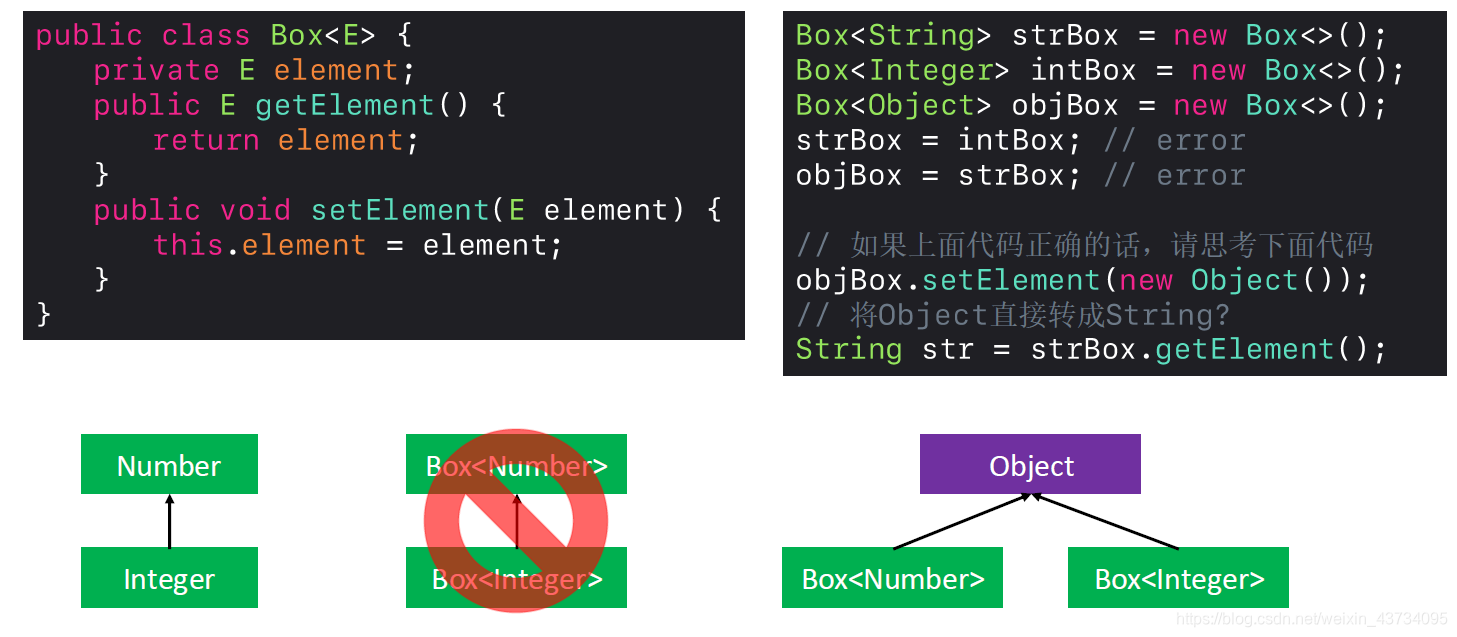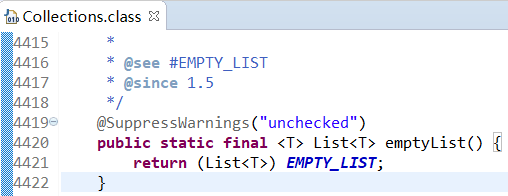泛型(Generics)
Java笔记目录可以点这里:Java 强化笔记(适合有基础的童鞋,不适合小白)
泛型(Generics)
从 Java 5 开始,增加了泛型技术
什么是 泛型?
- 将类型变为参数,提高代码复用率
建议的类型参数名称:
• T :Type
• E :Element
• K :Key
• N :Number
• V :Value
• S、U、V :2nd, 3rd, 4th types
泛型类型(Generic Type)
什么是泛型类型?
- 使用了泛型的类或者接口
比如:java.util.Comparator、java.util.Comparable
public class Student <T> {
private T score;
public T getScore() {
return score;
}
public void setScore() {
this.score = score;
}
}
// Java 7 以前的写法
Student<String> stu = new Student<String>();
// Java 7开始, 可以省略右边<>中的类型(钻石语法)
Student<String> stu1 = new Student<>();
stu1.setScore("A");
String score1 = stu1.getScore();
Student<Double> stu2 = new Student<>();
stu2.setScore(98.5);
Double score2 = stu2.getScore();
多个类型参数
public class Student <N, S> {
private N no;
private S score;
public Student(N no, S score) {
this.no = no;
this.score = score;
}
}
Student<String, String> s1 = new Student<>("E9527", "A++");
Student<Integer, Double> s2 = new Student<>(17210224, 96.5);
泛型类型的继承
如果没有泛型类型的类之间有继承关系,加了泛型类型后不一定会保持继承关系。
例如 Integer 类继承自 Number,但是 Box<Integer> 不继承 Box<Number>

只有泛型类型也相同时,原本有继承关系的类会继续保持继承关系。

如果拥有多个泛型类型,第一个泛型类型与父类的泛型类型相同,即可保持继承关系。
例如,下图中 MyList<String, Object> 与 List<String> 保持了继承关系。

原始类型(Raw Type)

泛型方法(Generic Method)
什么是泛型方法?
- 使用了泛型的方法(实例方法、静态方法、构造方法),比如
Arrays.sort(T[], Comparator<T>)
public class Main {
public static void main(String[] args) {
Student<String, String> s1 = new Student<>();
// 可以像下面这么写, 但一般不会写的这么麻烦
Main.<String, String>set(s1, "K99", "C++");
Student<Integer, Double> s2 = new Student<>();
// 编译器可以自动推断出类型参数的具体类型
set(s2, 25, 99.5);
}
// 泛型方法(静态方法)
static <T1, T2> void set(Student<T1, T2> stu, T1 no, T2 score) {
stu.setNo(no);
stu.setScore(score);
}
}
泛型方法示例:
public class Box<E> {
private E element;
public Box() {}
public Box(E element) {
this.element = element;
}
}
public class Main {
public static void main(String[] args) {
List<Box<Integer>> boxes = new ArrayList<>();
addBox(11, boxes);
addBox(22, boxes);
addBox(33, boxes);
}
// 泛型方法(静态方法)
static <T> void addBox(T element, List<Box<T>> boxes) {
Box<T> box = new Box<>(element);
boxes.add(box);
}
}
泛型方法 - 类型推断

上图是 jdk 中 Collections 类的源码,可以看出 emptyList() 是泛型方法,可以自动推断类型。
// 根据接收的类是 List<String> 推断出了泛型是 String 类型
List<String> list1 = Collections.emptyList();
// 根据接收的类是 List<Integer> 推断出了泛型是 Integer 类型
List<Integer> list2 = Collections.emptyList();
泛型方法 – 构造方法

限制类型参数
可以通过 extends 对类型参数增加一些限制条件,比如 <T extends A>
extends后面可以跟上类名、接口名,代表 T 必须是 A 类型,或者继承、实现 A
// <T extends Number> 表示传入的类型参数必须是Numbe及其子类
public class Person<T extends Number> {
private T age;
public <E> Person(T age) {
this.age = age;
}
public int getAge() {
// 传入null则视为0, 否则转为int
return (age == null) ? 0 : age.intValue();
}
}
public static void main(String[] args) {
Person<Double> p1 = new Person<>(18.7);
System.out.println(p1.getAge()); // 18
Person<Integer> p2; // 正常运行, Integer是Number的子类
// Person<String> p3; // 会报错, 因为String不是Number的子类
}
- 可以同时添加多个限制,比如
<T extends A & B & C>,代表 T 必须同时满足 A、B、C,只能有一个类,但是可以有多个接口,类必须放在前面
限制类型参数 — 接收泛型数组返元素最大值方法
public class Main {
public static void main(String[] args) {
Double[] ds = {5.6, 3.4, 8.8, 4.6};
System.out.println(getMax(ds)); // 8.8
Integer[] is = {4, 19, 3, 28, 56};
System.out.println(getMax(is)); // 56
}
static <T extends Comparable<T>> T getMax(T[] array) {
if (array == null || array.length == 0) return null;
T max = array[0];
for (int i = 0; i < array.length; i++) {
if (array[i] == null) continue;
if (array[i].compareTo(max) <= 0) continue;
max = array[i];
}
return max;
}
}
限制类型参数 — 要求传入的类型必须可比较
public class Student <T extends Comparable<T>> implements Comparable<Student<T>> {
private T score; // 传入的 T 继承了 Comparable<T>, 表示是可比较的
public Student(T score) {
this.score = score;
}
@Override
public int compareTo(Student<T> s) {
// 传入若为null, 必然比本身小
if (s == null) return 1;
// 若自身的score不为null, 则调用compareTo与传入的进行比较
if (score != null) return score.compareTo(s.score);
// 此时, 自身的score为null, 若传入的score也为null则视为相同, 否则就是传入的大
return s.score == null ? 0 : -1;
}
@Override
public String toString() {
return "Student [score=" + score + "]";
}
}
public class Main {
public static void main(String[] args) {
Student<Integer>[] stus = new Student[3];
stus[0] = new Student<>(18);
stus[1] = new Student<>(38);
stus[2] = new Student<>(28);
// Student [score=38]
System.out.println(getMax(stus));
}
static <T extends Comparable<T>> T getMax(T[] array) {
if (array == null || array.length == 0) return null;
T max = array[0];
for (int i = 0; i < array.length; i++) {
if (array[i] == null) continue;
if (array[i].compareTo(max) <= 0) continue;
max = array[i];
}
return max;
}
}
通配符(Wildcards)
- 在泛型中,问号
?被称为是通配符 - 通常用作变量类型、返回值类型的类型参数
- 不能用作泛型方法调用、泛型类型实例化、泛型类型定义的类型参数
通配符 — 上界(extends)
- 可以通过
extends设置类型参数的上界
基本使用:
// 类型参数必须是Number类型或者是Number的子类型
void testUpper(Box<? extends Number> box) {}
// Integer是Number的子类
Box<Integer> p1 = null;
testUpper(p1); // 可以
// Number类型可以作为参数
Box<Number> p2 = null;
testUpper(p2); // 可以
// ? extends Number 表示参数是Number的子类
Box<? extends Number> p3 = null; // 可以
testUpper(p3);
// ? extends Integer 表示参数是Integer的子类, Integer是Number的子类
Box<? extends Integer> p4 = null; // 可以
testUpper(p4);
// String不是Number的子类, 传入testUpeer会报错
Box<String> p5 = null;
// testUpper(p5); // 报错
示例:对泛型数组的元素求和方法(传入的必须是Number的子类型)
public class Main {
public static void main(String[] args) {
List<Integer> is = Arrays.asList(1, 2, 3);
System.out.println(sum(is)); // 6.0
List<Double> ds = Arrays.asList(1.2, 2.3, 3.5);
System.out.println(sum(ds)); // 7.0
}
static double sum(List<? extends Number> list) {
double s= 0.0;
for (Number n : list) {
s += n.doubleValue();
}
return s;
}
}
通配符 — 下界(super)
- 可以通过
super设置类型参数的下界
基本使用:
// 类型参数必须是Integer类型或者是Integer的父类型
void testLower(Box<? super Integer> box) {
Box<Integer> p1 = null;
testLower(p1);
Box<Number> p2 = null;
testLower(p2);
Box<? super Integer> p3 = null;
testLower(p3);
Box<? super Number> p4 = null;
testLower(p4);
示例:往泛型数组中添加元素(传入的必须是Integer的父类型)
public class Main {
public static void main(String[] args) {
List<Integer> is = new ArrayList<>();
addNumbers(is);
System.out.println(is); // [1, 2, 3, 4, 5]
List<Number> ns = new ArrayList<>();
addNumbers(ns);
System.out.println(ns); // [1, 2, 3, 4, 5]
}
static void addNumbers(List<? super Integer> list) {
for (int i = 1; i <= 5; i++) {
list.add(i);
}
}
}
通配符 — 无限制
// 类型参数是什么类型都可以
void test(Box<?> box) {}
Box<Integer> p1 = null;
Box<Integer> p2 = null;
Box<Integer> p3 = null;
Box<? extends Number> p4 = null;
Box<? super String> p5 = null;
Box<?> p6 = null;
test(p1);
test(p2);
test(p3);
test(p4);
test(p5);
test(p6);
示例:打印泛型数组的元素(无限制,任何类型都可以)
public class Main {
public static void main(String[] args) {
List<Integer> is = Arrays.asList(1, 2, 3);
printList(is); // 1 2 3
List<Double> ds = Arrays.asList(1.2, 2.3, 3.5);
printList(ds); // 1.2 2.3 3.5
}
static void printList(List<?> list) {
for (Object object : list) {
System.out.print(object + " ");
}
System.out.println();
}
}
通配符 – 继承
无限制的绝对是最顶层的,其余的按正常继承关系理解即可。

通配符 — 注意点

泛型的使用限制
这里列出一些常用的误区,不必死记,过一遍理解即可。






